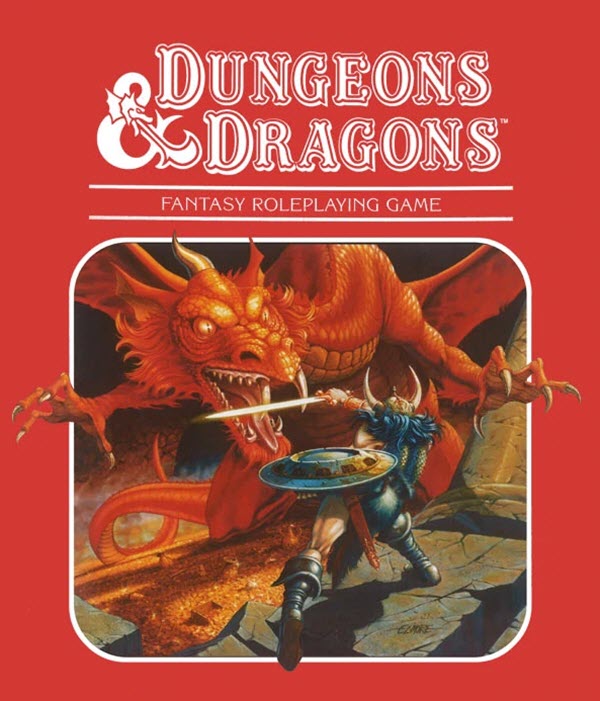Dungeons & Dragons
Contents
Dungeons & Dragons (D&D) is a fantasy tabletop role-playing game (RPG) first published in 1974.
Inspired by miniature wargames, the first version of D&D used a rule system borrowed (and modified) from the 1971 medieval miniature wargame Chainmail. A notable difference between D&D and traditional wargaming is that D&D allows for each player to create their own avatar character instead of dealing with military formations.
D&D is commonly recognized as the starting point for the modern role-playing era and its success in the 1970s served to kick-start the modern role-playing game industry. The popularity of D&D led to the creation of a multitude of similar game systems, but D&D is still the market leader today, nearly half a century after its original release. In 2004, when D&D was 30 years old, an estimated 20 million people had played the game, and worldwide books and equipment sales had reached $1 billion USD.
The only items required for a game of D&D are the rulebooks, a character sheet for each player, and a sufficient number of polyhedral dice. The most recent version of the rules is detailed in three core rulebooks: Player´s Handbook, Dungeon Master´s Guide, and Monster Manual.
Some gaming groups elect to use props, such as miniature figures placed on a grid map to visualize battles. (Some D&D editions even presume that the group have access to such props.)
Examples of optional accessories are expansion rulebooks, pre-designed adventurers and campaign settings.

Design and publishing
The original D&D was designed by Gary Gygax and Dave Arneson, and published in 1974 by Tactical Studies Rules, Inc.
From 1997 and onward, D&D has instead been published by Wizards of the Coast.
Publications
- 1974 (original)
- 1977 (Basic Set 1st ver.)
- 1977 (Advanced D&D)
- 1981 (Basic Set 2nd ver.)
- 1983 (Basic Set 3rd ver.)
- 1989 (AD&D 2nd Edition)
- 1991 (Rules Cyclopedia)
- 2000 (3rd edition)
- 2003 (v3.5)
- 2008 (4th edition)
- 2014 (5th edition)
What is AD&D?
In 1977, Dungeons & Dragons was split into two branches:
- The basic Dungeons & Dragons (D&D), which is comparatively rules-light.
- The Advanced Dungeons & Dragons (AD&D), which is rules-heavy and more structured.
Play overview
- Dungeons & Dragons is a structured but also essentially open-ended tabletop role-playing game.
- The basic setting for D&D is a high-fantasy world.
- A Dungeon Master (DM) serves as both storyteller and referee.
- Each participant create their own player character (PC). Together, these PC:s form a party and embark on an adventure. Throughout the adventure, they will interact with both each other and with the other creatures that populate the D&D world.
- Each PC has its own characteristics, including strengths and weaknesses. Thus, the members of the party is encouraged to work together to let their various PC abilities contribute to the total success of the group.
- The PC´s will explore, gather knowledge, solve dilemmas, engage in battles, and collect valuables. It is possible for a PC to earn experience points (XP), and collecting a sufficient number of points will make the PC more powerful than before.
- It is common for a game to continue over a series of sessions to complete a single adventure. A series of connected adventures is known as campaign.
Dice
Players of D&D use polyhedral dice to resolve many in-game events.
During the game, a player will describe their playing character’s (PC´s) intended action, e.g. picking up a map or picking a lock. If the action is trivial (e.g. picking up the map), it is typically announced successful by the DM without any use of dice. If the action is more complex (e.g. picking a lock), the player will be asked to roll the dice to let the dice determine the outcome.
Different polyhedral dice are used for different actions.
The various dice are abbreviated by the letter ”d” followed by the number of sides.
d4 = a dice with only four sides
d6 = the classic type of 6-sided dice
d8 = a dice with eight sides
d10 = a dice with ten sides
d12 = a dice with twelve sides
d20 = a dice with twenty sides
Example: In a combat situation, an d20 can be used to determine if a hit was made, while a d8 is used to determine how much damage it caused (if there was a hit)
In many situations, the outcome of the dice are combined with the character’s abilities to determine the result of an attempted action, which means that character characteristics such as ability scores ans skills will have an impact.